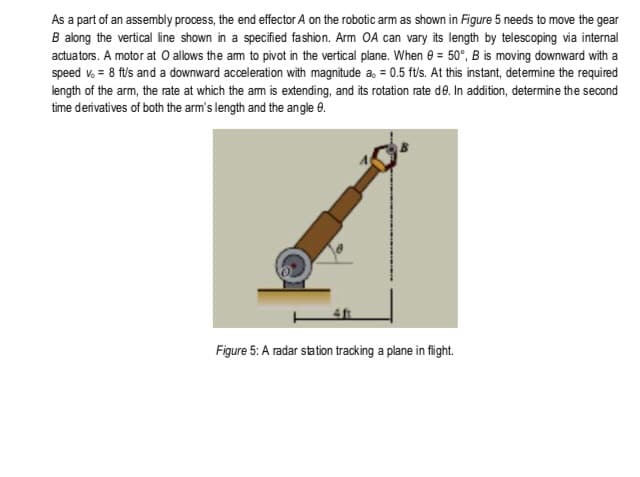As a part of an assembly process, the end effector A on the robotic arm as shown in Figure 5 needs to move the gear B along the vertical line shown in a specified fashion. Arm OA can vary its length by telescoping via internal actuators. A motor at O allows the am to pivot in the vertical plane. When e = 50°, B is moving downward with a speed v, = 8 fils and a downward acceleration with magnitude a, = 0.5 f's. At this instant, determine the required length of the arm, the rate at which the am is extending, and its rotation rate de. In addition, determine the second time derivatives of both the arm's length and the angle 0. Figure 5: A radar station tracking a plane in fight.
As a part of an assembly process, the end effector A on the robotic arm as shown in Figure 5 needs to move the gear B along the vertical line shown in a specified fashion. Arm OA can vary its length by telescoping via internal actuators. A motor at O allows the am to pivot in the vertical plane. When e = 50°, B is moving downward with a speed v, = 8 fils and a downward acceleration with magnitude a, = 0.5 f's. At this instant, determine the required length of the arm, the rate at which the am is extending, and its rotation rate de. In addition, determine the second time derivatives of both the arm's length and the angle 0. Figure 5: A radar station tracking a plane in fight.
Elements Of Electromagnetics
7th Edition
ISBN:9780190698614
Author:Sadiku, Matthew N. O.
Publisher:Sadiku, Matthew N. O.
ChapterMA: Math Assessment
Section: Chapter Questions
Problem 1.1MA
Related questions
Question

Transcribed Image Text:As a part of an assembly process, the end effector A on the robotic arm as shown in Figure 5 needs to move the gear
B along the vertical line shown in a specified fashion. Arm OA can vary its length by telescoping via internal
actuators. A motor at O allows the am to pivot in the vertical plane. When e = 50°, B is moving downward with a
speed v. = 8 f/'s and a downward aceleration with magnitude a, = 0.5 ft/s. At this instant, detemine the required
length of the arm, the rate at which the am is extending, and its rotation rate de. In addition, determine the second
time derivatives of both the arm's length and the angle 0.
4ft
Figure 5: A radar station tracking a plane in fight.
Expert Solution
This question has been solved!
Explore an expertly crafted, step-by-step solution for a thorough understanding of key concepts.
This is a popular solution!
Trending now
This is a popular solution!
Step by step
Solved in 2 steps with 3 images

Knowledge Booster
Learn more about
Need a deep-dive on the concept behind this application? Look no further. Learn more about this topic, mechanical-engineering and related others by exploring similar questions and additional content below.Recommended textbooks for you

Elements Of Electromagnetics
Mechanical Engineering
ISBN:
9780190698614
Author:
Sadiku, Matthew N. O.
Publisher:
Oxford University Press

Mechanics of Materials (10th Edition)
Mechanical Engineering
ISBN:
9780134319650
Author:
Russell C. Hibbeler
Publisher:
PEARSON

Thermodynamics: An Engineering Approach
Mechanical Engineering
ISBN:
9781259822674
Author:
Yunus A. Cengel Dr., Michael A. Boles
Publisher:
McGraw-Hill Education

Elements Of Electromagnetics
Mechanical Engineering
ISBN:
9780190698614
Author:
Sadiku, Matthew N. O.
Publisher:
Oxford University Press

Mechanics of Materials (10th Edition)
Mechanical Engineering
ISBN:
9780134319650
Author:
Russell C. Hibbeler
Publisher:
PEARSON

Thermodynamics: An Engineering Approach
Mechanical Engineering
ISBN:
9781259822674
Author:
Yunus A. Cengel Dr., Michael A. Boles
Publisher:
McGraw-Hill Education

Control Systems Engineering
Mechanical Engineering
ISBN:
9781118170519
Author:
Norman S. Nise
Publisher:
WILEY

Mechanics of Materials (MindTap Course List)
Mechanical Engineering
ISBN:
9781337093347
Author:
Barry J. Goodno, James M. Gere
Publisher:
Cengage Learning

Engineering Mechanics: Statics
Mechanical Engineering
ISBN:
9781118807330
Author:
James L. Meriam, L. G. Kraige, J. N. Bolton
Publisher:
WILEY